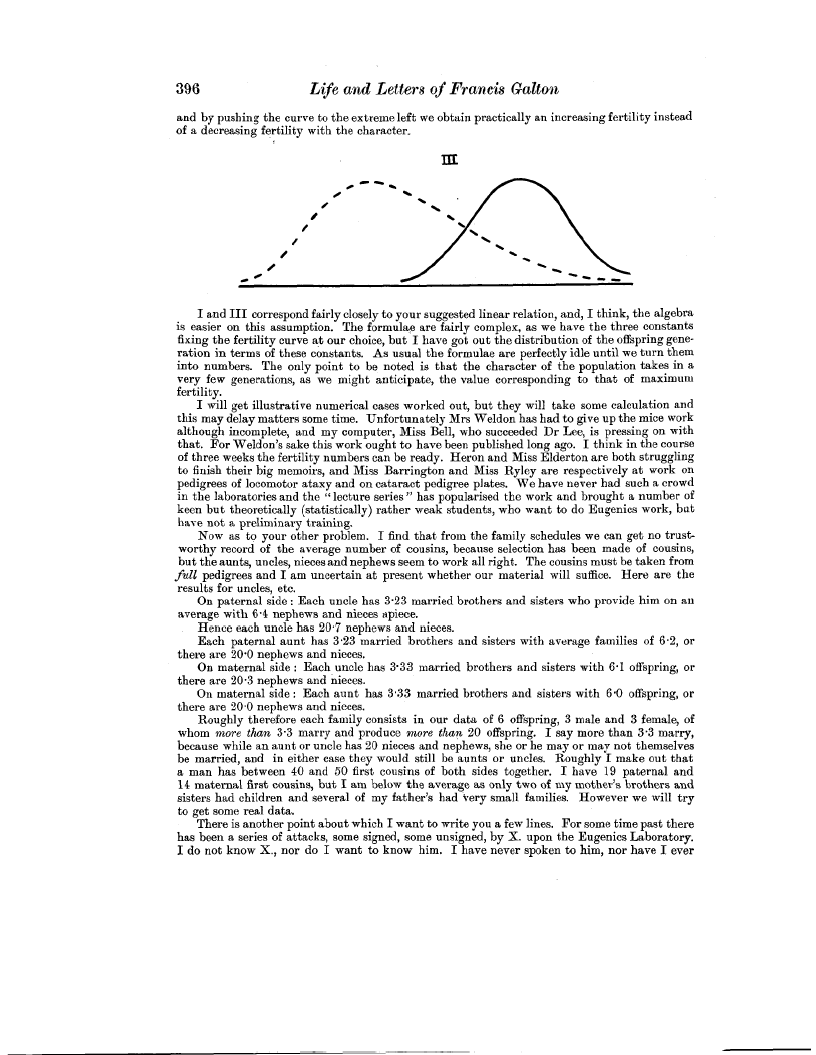| ||||||

OCR Rendition - approximate
396 Life and Letters of Francis Galton and by pushing the curve to the extreme left we obtain practically an increasing fertility instead of a decreasing fertility with the character. III  I and III correspond fairly closely to your suggested linear relation, and, I think, the algebra is easier on this assumption. The formulae are fairly complex, as we have the three constants fixing the fertility curve at our choice, but I have got out the distribution of the offspring generation in terms of these constants. As usual the formulae are perfectly idle until we turn them into numbers. The only point to be noted is that the character of the population takes in a very few generations, as we might anticipate, the value corresponding to that of maximum fertility. I will get illustrative numerical cases worked out, but they will take some calculation and this may delay matters some time. Unfortunately Mrs Weldon has had to give up the mice work although incomplete, and my computer, Miss Bell, who succeeded Dr Lee, is pressing on with that. For Weldon's sake this work ought to have beer, published long ago. I think in the course of three weeks the fertility numbers can be ready. Heron and Miss Elderton are both struggling to finish their big memoirs, and Miss Barrington and Miss Ryley are respectively at work on pedigrees of locomotor ataxy and on cataract pedigree plates. We have never had such a crowd in the laboratories and the '1 lecture series" has popularised the work and brought a number of keen but theoretically (statistically) rather weak students, who want to do Eugenics work, but have not a preliminary training. Now as to your other problem. I find that from the family schedules we can get no trustworthy record of the average number of cousins, because selection has been made of cousins, but the aunts, uncles, nieces and nephews seem to work all right. The cousins must betaken from full pedigrees and I am uncertain at present whether our material will suffice. Here are the results for uncles, etc. On paternal side : Each uncle has 3.23 married brothers and sisters who provide him on an average with 6.4 nephews and nieces apiece. Hence each uncle has 20.7 nephews and nieces. Each paternal aunt has 3.23 married brothers and sisters with average families of 6.2, or there are 20.0 nephews and nieces. On maternal side : Each uncle has 3.33 married brothers and sisters with 6.1 offspring, or there are 20.3 nephews and nieces. On maternal side : Each aunt has 3.33 married brothers and sisters with 6.0 offspring, or there are 20.0 nephews and nieces. Roughly therefore each family consists in our data of 6 offspring, 3 male and 3 female, of whom more than 3.3 marry and produce more than 20 offspring. I say more than 3.3 marry, because while an aunt or uncle has 20 nieces and nephews, she or he may or may not themselves be married, and in either case they would still be aunts or uncles. Roughly I make out that a man has between 40 and 50 first cousins of both sides together. I have 19 paternal and 14 maternal first cousins, but I am below the average as only two of my mother's brothers and sisters had children and several of my father's had very small families. However we will try to get some real data. There is another point about which I want to write you a few lines. For some time past there has been a series of attacks, some signed, some unsigned, by X. upon the Eugenics Laboratory. I do not know X., nor do I want to know him. I have never spoken to him, nor have I ever
|